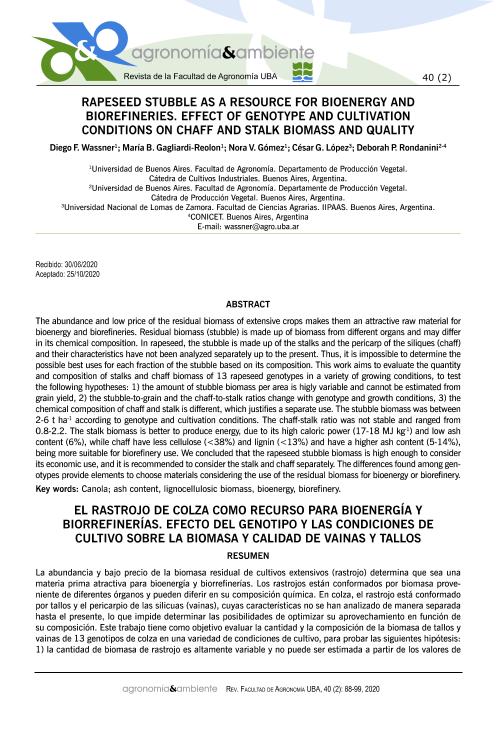Artículo
La abundancia y bajo precio de la biomasa residual de cultivos extensivos (rastrojo) determina que sea una materia prima atractiva para bioenergía y biorrefinerías. Los rastrojos están conformados por biomasa proveniente de diferentes órganos y pueden diferir en su composición química. En colza, el rastrojo está conformado por tallos y el pericarpio de las silicuas (vainas), cuyas características no se han analizado de manera separada hasta el presente, lo que impide determinar las posibilidades de optimizar su aprovechamiento en función de su composición. Este trabajo tiene como objetivo evaluar la cantidad y la composición de la biomasa de tallos y vainas de 13 genotipos de colza en una variedad de condiciones de cultivo, para probar las siguientes hipótesis: 1) la cantidad de biomasa de rastrojo es altamente variable y no puede ser estimada a partir de los valores de rendimiento de grano, 2) la proporción entre rastrojo y grano y entre vaina a tallo cambian con el genotipo y las condiciones de crecimiento del cultivo, 3) la composición química de la vaina y el tallo es diferente lo que justifica un aprovechamiento separado. La biomasa seca total de rastrojo fue de entre 2-6 t ha-1 según genotipo y condiciones de cultivo. La relación vaina-tallo no estable y osciló entre 0.8-2.2. La biomasa del tallo es adecuada para producir energía, debido a su alto poder calórico (17-18 MJ kg-1) y bajo contenido de cenizas (6%). Las vainas tienen menos celulosa (<38%) y lignina (<13%) y un contenido mayor de cenizas (5-14%), siendo más adecuadas para aprovechamientos de biorrefinería. Se concluye que la cantidad de rastrojo de colza es elevada lo que permite considerar su aprovechamiento económico, pero se recomienda considerar los tallos y las vainas por separado. Las diferencias encontradas entre genotipos aportan elementos para elegir materiales considerando el uso de la biomasa de rastrojo para bioenergía o biorrefinería. The abundance and low price of the residual biomass of extensive crops makes them an attractive raw material for bioenergy and biorefineries. Residual biomass (stubble) is made up of biomass from different organs and may differ in its chemical composition. In rapeseed, the stubble is made up of the stalks and the pericarp of the siliques (chaff) and their characteristics have not been analyzed separately up to the present. Thus, it is impossible to determine the possible best uses for each fraction of the stubble based on its composition. This work aims to evaluate the quantity and composition of stalks and chaff biomass of 13 rapeseed genotypes in a variety of growing conditions, to test the following hypotheses: 1) the amount of stubble biomass per area is higly variable and cannot be estimated from grain yield, 2) the stubble-to-grain and the chaff-to-stalk ratios change with genotype and growth conditions, 3) the chemical composition of chaff and stalk is different, which justifies a separate use. The stubble biomass was between 2-6 t ha-1 according to genotype and cultivation conditions. The chaff-stalk ratio was not stable and ranged from 0.8-2.2. The stalk biomass is better to produce energy, due to its high caloric power (17-18 MJ kg-1) and low ash content (6%), while chaff have less cellulose (<38%) and lignin (<13%) and have a higher ash content (5-14%), being more suitable for biorefinery use. We concluded that the rapeseed stubble biomass is high enough to consider its economic use, and it is recommended to consider the stalk and chaff separately. The differences found among genotypes provide elements to choose materials considering the use of the residual biomass for bioenergy or biorefinery.
Rapeseed stubble as resource for bioenergy and biorefineries: Effect of genotype and cultivation conditions on chaff and stalk biomass and quality
Título:
El rastrojo de colza como recurso para bioenergía y biorrefinerías: Efecto del genotipo y las condiciones de cultivo sobre la biomasa y calidad de vainas y tallos
Wassner, Diego Fernan; Gagliardi Reolon, María B.; Gomez, Nora V.; Lopez, Cesar Gabriel ; Rondanini, Deborah Paola
; Rondanini, Deborah Paola
 ; Rondanini, Deborah Paola
; Rondanini, Deborah Paola
Fecha de publicación:
11/2020
Editorial:
Universidad de Buenos Aires. Facultad de Agronomía
Revista:
Agronomia y Ambiente
ISSN:
2344-9039
e-ISSN:
2314-2243
Idioma:
Inglés
Tipo de recurso:
Artículo publicado
Clasificación temática:
Resumen
Palabras clave:
CANOLA
,
CENIZAS
,
BIOMASA LIGNOCELULÓSICA
,
BIORREFINERÍA
Archivos asociados
Licencia
Identificadores
Colecciones
Articulos(OCA PQUE. CENTENARIO)
Articulos de OFICINA DE COORDINACION ADMINISTRATIVA PQUE. CENTENARIO
Articulos de OFICINA DE COORDINACION ADMINISTRATIVA PQUE. CENTENARIO
Citación
Wassner, Diego Fernan; Gagliardi Reolon, María B.; Gomez, Nora V.; Lopez, Cesar Gabriel; Rondanini, Deborah Paola; Rapeseed stubble as resource for bioenergy and biorefineries: Effect of genotype and cultivation conditions on chaff and stalk biomass and quality; Universidad de Buenos Aires. Facultad de Agronomía; Agronomia y Ambiente; 40; 2; 11-2020; 88-99
Compartir



